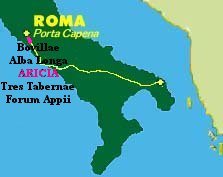
Our next stop on the road is Aricia, where Horace too spent his first night after leaving Rome. We will pass through Bovillae and Alba Longa before arriving at Aricia. Bovillae is the the area where the famous murder of Clodius is said to have occurred.
In Alba Longa we see the tomb of Pompey. Continuing along the road, one finds signs indicating the site of the tombs of the legendary Horatii and Curiatii. A large monument sits on the left side of the road, but it seems to date from the period of the republic rather than that of the monarchy. Despite the fact that all efforts are made to keep the Via Appia as straight as possible, when the engineers came to the site of the tombs of the Horatii and Curiatii, the road was curved to go around the tombs.
We arrive next at Aricia and are amazed at a huge viaduct that is more than 800 ft. long, 18 ft. wide in its greatest width, and almost 45 ft. high. Two arches near the beginning allow run off of excessive rain and also serve as hiding places for robbers and beggars. The poet Juvenal, in scorning a man, wrote he was "well fitted to beg at the wheels of chariots as they rolled down the Arician hill." Going down the hill was most likely safer than going up, when the slow pace of the climb made passengers vulnerable to thieves. Horace says the inn here was quiet, unlike the usual raucous, dirty and crowded inns one usually found. This coin, issued by the moneyer P. Accoleius Lariscolus in 43 BCE, shows three female archaic cult statues which were located in his home town of Aricia.
We might stop next at Forum Appii, which is often referred to in ancient itineraries, so we are assured that the road did indeed pass through this town. Horace refers to receiving bad water here. Romans were used to having good water from their fine aqueduct system and thus quick to complain when the water did not meet their standards. It was in this town too that St.Paul is said to have met with the faithful in 60 AD en route to Rome. He had been escorted from Jerusalem, shipwrecked at Malta. He landed at Misenum and was brought overland to Rome, on the Appian Way for much of his journey.